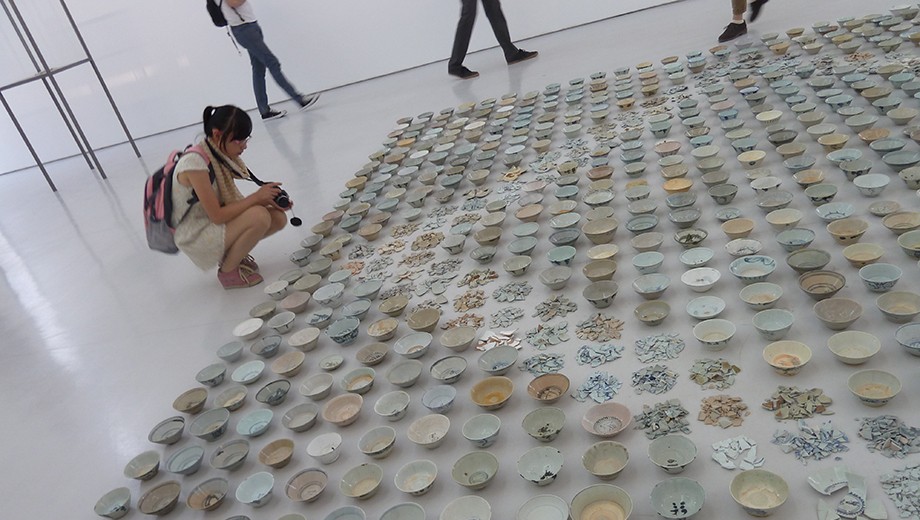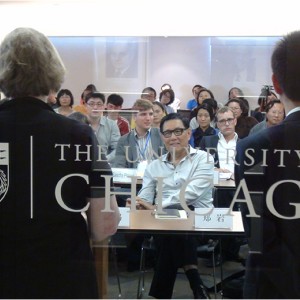Josef Stern knew the idea of a conference on Jewish studies in Beijing was unconventional.
Early on, some of his colleagues were “frankly, somewhat skeptical,” admits Stern, the William H. Colvin Professor in Philosophy and director of the Chicago Center for Jewish Studies.
Yet with the help of contacts in China, Stern was able to gather a robust group of scholars and students from China and the West to attend the conference "Maimonides and Medieval Jewish Thought" at the University’s Center in Beijing.
The April event focused on the work of the medieval rabbinic scholar and philosopher Maimonides, whose twelfth-century Guide of the Perplexed is arguably the greatest medieval text in Jewish philosophy.
“There turned out to be considerable interest,” Stern says. The Jewish studies community in China is “relatively small, but it’s growing. The students are superb.”
The collaboration was so fruitful that Stern is organizing another conference in Beijing on Jewish and Chinese ethics, tentatively planned for spring 2013.
Since opening two years ago, the Center in Beijing has become a major draw for China specialists from across the Division of the Humanities, including faculty who teach in College study-abroad programs and scholars whose work has brought them to East Asia for decades. Lectures and conferences have spanned topics from Chinese opera film to contemporary ink painting to ancient history.
Yet the center also has opened its doors to humanities scholars whose work lies outside the field of Chinese studies. For example, Shadi Bartsch-Zimmer, the Helen A. Regenstein Distinguished Service Professor in Classics, has long studied Roman literature and culture. In 2012, she traveled to Beijing to host a conference investigating modern China’s engagement with Greco-Roman antiquity.
“It is extremely gratifying to see such a rich variety of projects at the center, and to see University of Chicago scholars making strong connections with their counterparts from across China,” says Dali Yang, a professor in Political Science and the center’s faculty director. “There’s a remarkable diversity of interest among Chinese scholars, so they’re very open to exploring new cultures,” adds Stern.
Making sense of the foreign
In November 2011, Thomas Christensen, the Avalon Foundation Professor in Music, helped organize "Music Theory between East and West," a three-day conference that attracted students and teachers from top Chinese conservatories as well as Western scholars of music theory.
The event was designed in part to celebrate the 2011 publication of the Chinese edition of The Cambridge History of Western Music Theory. Christensen edited the English edition of the more than 1,000-page volume. As he noted at the conference, there was only one earlier translation of the book—into Macedonian—and the Chinese translation “expanded by a factor of some 650 the potential number of non-English readers.”
With globalization, Western audiences have gained interest in Chinese music, but in China, “much of music theory is oriented toward teaching Western music,” Christensen explains. “It’s not dealing with indigenous Chinese classical music. That’s fallen behind in interest.” He says Chinese conference participants were especially interested in pedagogy and using music theory to improve musicianship, in contrast to many Western scholars.
Despite subtle differences in approach, Christensen hopes music theory might help bridge gaps between the East and West. “Music theory might play a role in helping us translate the many musical languages to which we are now constantly exposed,” he said at the conference. “For music theory is, if anything, a means by which people make sense of something that is often difficult, perplexing, and foreign.”
Art and antiquity
[wysiwyg_field contenteditable="false" wf_deltas="0" wf_field="field_article_images" wf_formatter="image" wf_settings-image_link="content" wf_settings-image_style="featured-img-landscape" wf_cache="1350663055" wf_entity_id="89" wf_entity_type="node"]
“Difficult and perplexing” could also describe the state of China’s antiquities market, according to Lawrence Rothfield (right), an associate professor in English, who gave a lecture titled “Antiquities Under Siege” at the center in June 2012. Although Rothfield’s talk focused on looting in Iraq, Egypt, and Libya, discussion quickly turned to the fate of China’s own antiquities.
The country’s massive economic boom has “led to some big problems in terms of tombs being dug up around the country, corruption, and a loss of knowledge about the past,” says Rothfield. “That’s why I wanted to go to China—to begin to look at what the problem was, and to see how the problem was understood from the point of view of the Chinese themselves.”
The visit also allowed Rothfield to discuss his research on urban cultural scenes at several universities outside Beijing. At Shandong University in Jinan, Rothfield met with civic leaders, and they discussed ways to improve the neighborhood adjoining the university.
“It was like a psychoanalytic session,” Rothfield jokes. “It took us a while to get to the city’s deeper anthropological and social qualities.” Yet the discussion also revealed that Jinan is undergoing massive demographic change, “with new ethnic groups with different attitudes, tastes, and manners posing a challenge to the self-image of the city, in a way not unlike the experience Chicago has had in incorporating waves of immigration and migration.”
China’s urban cultural landscape—and particularly its art scene—also has been on Laura Letinsky’s mind. In September Letinsky, a professor in Visual Arts, took 14 MFA students to Beijing to explore China’s exploding contemporary art community. Assistant Professor Geof Oppenheimer accompanied them.
In previous years, the department had led trips to New York to help familiarize students with the art world. But after visiting China in 2011, “I realized that taking them to Beijing would give them a broader, global view of art practice,” Letinsky explains.
Certainly, there are many similarities between the US and Chinese art markets: “Art is a commodity, and it’s also an intellectual activity that incites dialogues,” says Letinsky, but “the philosophical tradition is different. All of that has resulted in a different emphasis in attitudes toward labor and individualism and community.”
During the trip, students met with artists, curators, and gallery staff to learn how artists navigate the global art market. Letinsky said before the group departed, “I think it’ll blow their minds—in a great way.”



Add new comment